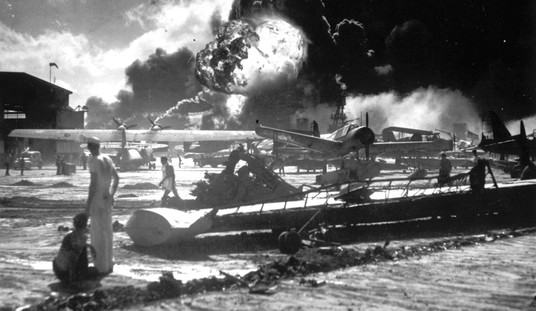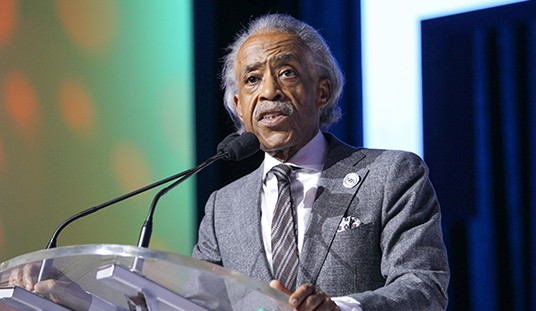My esteemed colleague Richard Fernandez recently discussed Shattered Sword, inarguably the best history written about the Battle of Midway. It’s likely to be the best that will ever be written, barring the rediscovery of some lost treasure trove of first-hand Japanese accounts. If you haven’t read it, I can’t urge you enough to get to Amazon or Borders or wherever and pick up a copy today, right now. The link in the title will take you straight to Amazon.
I’ll wait here for you.
The reason I bring it up is its authors — Jonathan Parshall and Anthony Tully — discussed in depth Japan’s problematical strategic position before and during the war, and I find that position relates almost precisely to NATO today.
Parshall and Tully argue that Japan would have been unlikely to have taken Midway from us, even had it been the US Navy which had lost the heart of its carrier force during the battle. Our Marines were dug in too well, the beaches would have been too difficult to assault, and anyway Japan lacked the doctrine or equipment to make it happen. Furthermore, taking Midway would have been a mistake at the operational-strategic level, which is where we get into Japan’s dilemma.
At the start of the war, and really just until very recently, Japan was the industrial heart of East Asia. China and India were both feudal societies for all intents, barely able to feed themselves. The rest of the region was equally backwards by Western (or even Japanese) standards of the time. So every square mile Japan conquered was another square mile Japan had to defend, but none of those square miles added to Japan’s industrial base, which was already stretched thin by the needs of war. Taking Midway would have added further stress to Japan’s undersized transport fleet, overtaxed by the needs of keeping Japanese troops supplied throughout China, Manchuria, Korea, Dutch Indonesia, the Philippines, Burma, and countless Pacific islands and atolls. Distant Midway would have been a rather large straw on the back of a very tired camel.
In contrast, when Germany took Czechoslovakia, they gained the Skoda Works and shortened borders to defend in the east. When the Germans took France, they gained France’s massive shipyards and the Atlantic Wall. Germany’s early conquests tended to be self-reinforcing in this way while Japan’s were anything but.
Which brings us to a Reuters writeup of a recent leak to Germany’s Spiegel magazine:
NATO would struggle to defend the Baltic states from any Russian aggression “with conventional means”, Germany’s Spiegel magazine reported on Sunday, citing sources close to the organization and a draft of a NATO planning document.
Eastern European states are nervous about Russia after it annexed Ukraine’s Crimea region and massed 40,000 troops on Ukraine’s borders.
The United States has sent 600 soldiers to the three Baltic countries – Estonia, Latvia and Lithuania – and Poland to take part in exercises to bolster NATO’s presence in eastern Europe.
“Russia’s ability and intention to undertake significant military action without much forewarning poses a far-reaching threat for the maintenance of security and stability in the European-Atlantic area,” the weekly magazine said, citing a NATO defense planning committee document.
Russia is capable of building up a local or regional military threat at short notice and at an arbitrary spot, the draft document continued.
Russia today enjoys in Eastern Europe the advantage enjoyed by the United States in the Pacific after Midway — the ability to pick when and where to strike against an overstretched adversary.
The end of the Cold War brought East Germany into the West, and the Soviet Army out of Eastern Europe. Both “sides,” if that word could still be used correctly after the dissolution of the Soviet Union and of the Warsaw Pact, rapidly drew down their forces. Russia’s smaller forces were responsible for defending a correspondingly smaller area. NATO, in the years following its decisive Cold War victory, took on not just eastern Germany, but Poland, the Czech Republic, Slovakia, Hungary, Romania, Bulgaria, Slovenia, Croatia, Lithuania, Latvia, and Estonia. Even tiny Albania got a seat on the North Atlantic Council. The whole of the former Warsaw Pact, plus three former Soviet republics, were all brought on board. NATO nearly doubled the number of member nations, significantly increased the square miles requiring defending, while significantly cutting defense budgets and the number of men and women under arms.
It’s almost as if Japanese Admiral Chūichi Nagumo, having failed to detect any American aircraft carriers on the morning of June 6, 1942, simply decided to scuttle his own carriers — and then without air cover proceed with the invasion of an island his country had no real need for.
Oftentimes the best way to keep the peace is the simplest one: Distance. I can’t tell you how many times I’ve had to take my squabbling sons, ages eight and three, and send them to separate rooms. A modern cordon sanitaire of the former Warsaw Pact nations would have provided a nice buffer between Russia and the West, while simultaneously reducing Russian paranoia regarding Western intentions. Instead, we brought our military alliance inside the borders of the old Soviet Union — although admittedly Moscow’s Baltic border had been illegally and ruthlessly set during Stalin’s brief alliance with Hitler.
But seen from Moscow’s angle, there might not be a huge world of difference between Nazi Panzer IVs at the gates of Moscow in 1941, and NATO Leopard IIs on the border with Ukraine in our time.
I don’t mention this to excuse Vladimir Putin’s actions in Crimea or in Ukraine’s fractured east. Indeed, President Obama was right — although uselessly right — when he described Putin’s mini invasion as a “clear violation” of Ukrainian sovereignty. But Putin’s provocations, and the West’s impotence in the face of them, do serve to illustrate the folly of expanding a military alliance without the commensurate expanse of military force to defend it.
(Thumbnail on PJM homepage based on a modified Shutterstock.com image.)










Join the conversation as a VIP Member